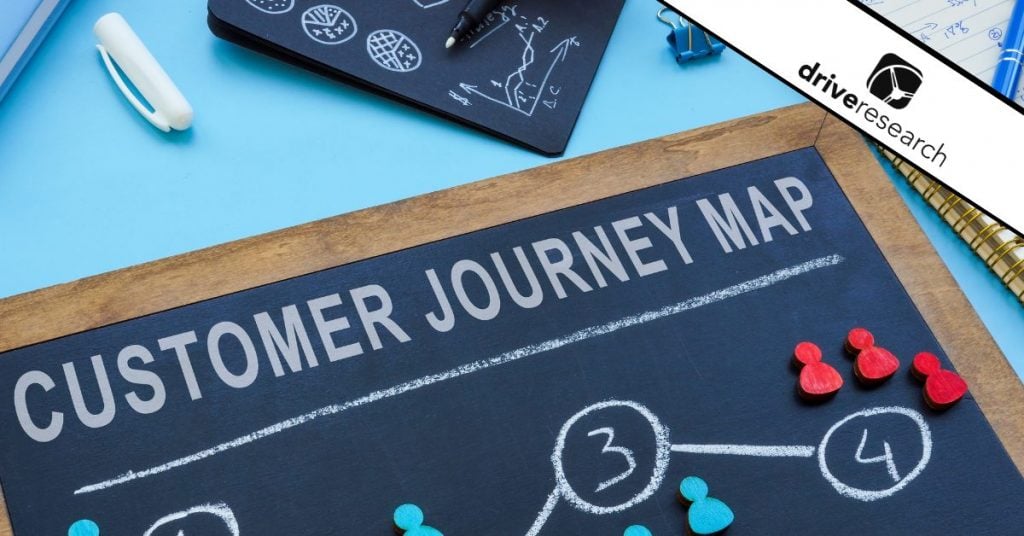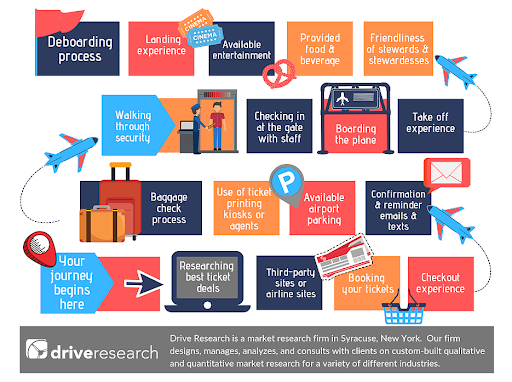
Identifying and measuring the intricacies of customer interactions is necessary for any business. This is where customer journey mapping steps into the spotlight.
It’s more than just a visual representation; it’s a strategic compass that guides businesses toward a deeper understanding of their customer’s experiences. In this blog post, our market research company defines journey mapping, the importance of journey maps, and the process of creating a data-driven journey map.
What is Customer Journey Mapping?
First things first, let’s share a brief definition.
The Definition of Customer Journey Mapping
Customer journey mapping is the process of boiling down all touchpoints and interactions a customer has with a company, organization, or brand into one path to purchase.
It is a technique used in market research, customer experience (CX) surveys, marketing strategy, and operations to help outline all of the potential touchpoints a customer or potential customer has on their path to purchase a product or service.
In a sense, journey mapping forces brands to think about their marketing and sales strategy differently. Not as a single component, but as a service that integrates all facets of an organization.
Example of a Customer Journey Map [With Image]
For example, pick an airline company. Delta. Southwest. Jet Blue. You choose.
Now think about all of the potential touchpoints a customer has with that airline from the time they decide to take a trip to the time they arrive at the destination.
A journey map highlights all of the relevant touchpoints for the organization.
Here are just a few of the touchpoints outlined in the journey map:
- Airline website: how the customer looks up, reviews, and books tickets on the site
- Email: think about the confirmation emails, reminder emails, check-in emails
- Kiosk: arriving at the airport, this would be the customer printing tickets, adding baggage, etc.
- On-flight experience: boarding the plane, service while on-flight, food and beverages
- Post-flight survey: email survey asking how the experience was, what can be improved, etc.
Now, these are only simple examples of touchpoints. In reality, each of those touchpoints has touchpoints within them and they could be further broken down.
On top of this, there are several other points along the airline customer journey we did not outline in the list of 5.

The Importance of Journey Mapping
Graphically appealing deliverables such as journey maps force brands to digest and display the insights and numbers in an easy to comprehend and visually appealing fashion.
In a way all can understand, not just those who have a background in statistics.
They become shareable pieces of information for all divisions in an organization, not just the math nerds.
Here are more unique benefits that highlight the importance of journey mapping.
1. Better Understand the Customer Experience
Journey mapping helps your organization understand the entire customer experience (CX) including every touchpoint along the way.
The maps help you understand all points of a journey that are often missed by quantitative surveying.
For example, a journey map might detail a heavy amount of search for a product or service in the research phase.
Answering a question such as, “How visible is our brand on Google?” is often difficult to assess or measure with online surveys.
2. Visualize Customer Patterns
Customer journey mapping plays a pivotal role in understanding and optimizing the customer experience.
Meticulously identifying all touchpoints in a customer’s interaction with a brand provides a comprehensive view of their journey from one step to the next.
This insight enables organizations to gain a holistic perspective on how customers engage with their products, services, and messaging.
Moreover, customer journey mapping empowers a brand to visualize patterns in customer behavior and preferences. It unveils critical moments of interaction, shedding light on pain points, moments of delight, and areas where improvements can be made.
All in all, this visual representation serves as a powerful tool for decision-makers, allowing them to see the journey in its entirety and make informed strategic choices.
3. Identify Gaps in Your Current CX Programs
Journey mapping in market research will also help you identify gaps in your current CX or Voice of Customer (VoC) programs where no feedback is being obtained.
This is the ultimate goal of journey mapping: to ensure all important touchpoints have a measurement tool in place to monitor them.
For example, let’s say a hotel conducts a customer survey and finds that 58% of reservations come through their website.
The survey also gathers feedback about the ease of use of the website, improvements to the site, and so on.
While this feedback is helpful, does it really explore the user experience (UX) of your website?
A customer journey map can help you understand and place emphasis on specific areas of the customer journey that need it the most.
It walks you through all steps including research and planning, shopping, booking, pre-travel, travel, and post-travel.
Steps to Mapping the Customer Journey
Step #1: Conduct a Customer Survey
First and foremost, it’s important to collect relevant data on customer interactions, behaviors, preferences, and feedback.
What your organization views as a strength in the customer journey may not be viewed as a strength by the same customers.
This is often why an organization starts with a broad customer satisfaction survey as a first step before drawing a journey map.
Watch this video to learn what our market research professionals believe are the most important questions to include in a customer survey.
Step #2. List Each Customer Touchpoint
Identify and list all the touchpoints where customers interact with your brand. This includes online channels (website, social media, email) as well as offline channels (in-store, phone support, events).
Then, determine the chronological order in which customers encounter these touchpoints to help visualize the flow of their journey.
Step #3. Analyze Customer Feedback for Each Touchpoint
Rely on your customer survey results to add context to each touchpoint you listed in the previous step.
For example, the survey can help you understand the specific goals that customers aim to achieve at each touchpoint.
What are they trying to accomplish, and what actions do they take?
Also, use your customer satisfaction survey data to measure the emotional state of customers at each touchpoint.
Do this by identifying moments of delight, frustration, confusion, and satisfaction and also pinpoint pain points and areas that need improvement.
Step #4: Create a Map of the Customer Journey
Once you have each laid out, you will need to create a comprehensive map and overview of the journey including each touchpoint (no matter how small or minor).
This can be achieved by creating a flowchart or diagram. This makes it easier to communicate and share insights across the organization.
Step #5: Identify Areas of Opportunity
Finally, identify the areas that need the most improvement. These touchpoints become your priority focus for the next steps and outcomes.
The ultimate goal of a customer journey map is to make the following claim:
“We reviewed our typical customer journey from Steps A to J. We are able to measure 80% of these steps currently but we realized that among the 20% that are not currently measured, two of those unmeasured steps have a large impact on satisfaction, loyalty, and purchase intent on our brand. These priority areas need to be further examined through market research using both VoC and UX.”
This type of solution statement is a typical next step or recommendation from customer journey mapping.
As with any research, a journey map answers a lot of questions for your organization but will also likely raise a few others which leads to continual improvement.
Contact Our CX Market Research Company
Drive Research is a national market research company. We work with organizations across the country on VoC, CX, and UX needs.
Need a proposal on journey mapping or a CX program? Contact our team today.



